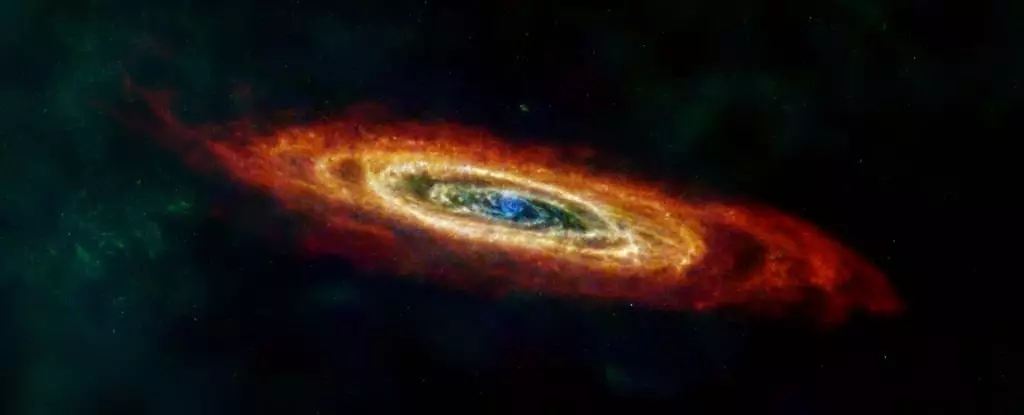The life cycle of a massive star is a remarkable journey defined by a delicate balance between two opposing forces: the outward pressure exerted by nuclear fusion and the inward pull of gravity. Stars that begin their lives with a mass significantly greater than our Sun—typically around eight solar masses or more—eventually reach a climax that results in an extraordinarily explosive finale known as a supernova. This explosive death is often perceived as the defining characteristic of massive stars, marking their transition into either a neutron star or a black hole. However, recent discoveries have brought to light an alternative fate that these celestial giants can meet: the phenomenon of “failed supernovae,” where the massive star collapses into a black hole without the grandiose explosion that typically heralds such a transformation.
Astrophysicists are increasingly intrigued by the notion that not all massive stars fulfill their expected destinies of cataclysmic explosion. The case of M31-2014-DS1, a supergiant star located in the Andromeda galaxy, offers intriguing new evidence of this phenomenon. Discovered through mid-infrared observations in 2014, this star exhibited an unusual behavior: it maintained a constant brightness for a substantial period before experiencing a dramatic fading over a thousand-day span. The peculiar trajectory of M31-2014-DS1 has prompted a reevaluation of our understanding of stellar evolution and the processes that govern these massive entities.
The research spearheaded by Kishalay De and his team paints a detailed picture of M31-2014-DS1. Initially estimated to possess a mass of around 20 times that of our Sun, the star somehow transitioned into a phase of nuclear inactivity, losing a significant portion of its mass in the process. By the end of its lifecycle, only a fraction of its original mass remained, yet it eluded the expected supernova explosion. Instead, the researchers highlight the star’s gradual dimming, pointing to its inability to generate the requisite energy to fuel an explosive outburst.
This striking observation of M31-2014-DS1 raises fundamental questions about how we define and understand supernovae. Traditionally, core-collapse supernovae are categorized as Type II explosions—one of the key mechanisms facilitating the spread of heavy elements across the universe while simultaneously initiating new star formation. The unexpected behavior of M31-2014-DS1 suggests that the complexities of stellar evolution may be richer and more nuanced than conventionally understood.
Astronomers suspect that the mechanism behind a failed supernova revolves around the intricate dynamics involving neutronization, a process initiated when a massive star’s core collapses. During this phase, electrons and protons combine to form neutrons, releasing an outpouring of neutrinos—almost ghostly particles that interact minimally with matter. While this enigmatic neutrino shock can theoretically catalyze an explosive release of energy, sometimes it fails to reignite the star’s external layers, resulting in an anticlimactic collapse rather than a brilliant supernova.
The implications of a star like M31-2014-DS1 failing to produce a supernova are substantial for our understanding of the universe. If a significant portion of massive stars is destined to silently collapse into black holes, rather than exploding, this could change the narrative about how black holes are formed and how often they arise. Existing models that predict the frequency of these events may require recalibration based on new data suggesting that anywhere between 20% to 30% of massive stars might end their lives without a classic supernova explosion.
Such findings challenge astronomers to reconsider the broader cosmic landscape. The materials ejected from supernovae play a pivotal role in disseminating heavy elements necessary for planet formation and the emergence of life. If many stars do not end with the spectacular ejecta traditionally expected of a supernova, it could reshape our theories about element dispersion in the galaxy and the resultant evolution of future star systems.
As we continue to unravel the ancient and complex stories written into the fabric of the cosmos, the case of M31-2014-DS1 stands as a testament to the hidden complexities of stellar evolution. The phenomenon of failed supernovae illuminates the myriad ways in which massive stars can meet their ends, provoking curiosity and prompting further investigation. As astronomers delve deeper into these enigmatic deaths, we may yet discover that the universe’s cosmic narratives are even more fascinating and varied than we have previously imagined. Embracing the unknown can only enhance our understanding of the universe and our unique place within it.


Leave a Reply